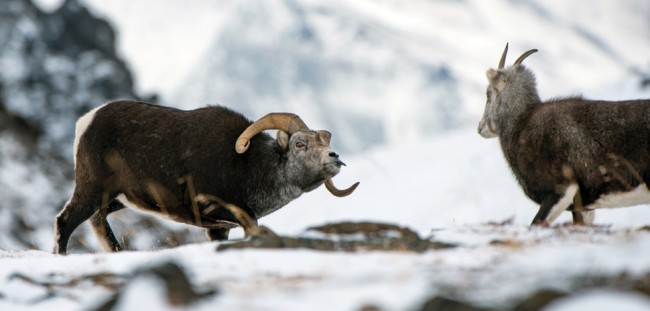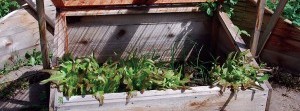
Photo Credit: Paul Colangelo
Spectacular Spatsizi—Vast wilderness with a rich history and uncertain future
Our horses walked slowly into a biting winter wind, making fresh tracks across the sparkling snow. Withered grass, lichen, sharp rock and snow patches extended across the rolling plateau while distant high mountains were visible in all directions. We were hunting caribou high up in Spatsizi Plateau Wilderness Provincial Park, which is located east of Hwy 37, approximately 370 km north of Kitwanga and 150 km southeast of Dease Lake.
Spatsizi Park forms the backbone of an interconnected wilderness region that is geologically unique and supports one of the few healthy large -mammal ecosystems in BC. The park, and Gladys Lake Ecological Reserve within it, was created in 1975 in response to pressure from outfitter Tommy Walker and Vladimir Krajina, a visionary of BC’s ecological reserves who recognized the area’s value. Following its creation, well-known ethnobotanist Wade Davis became one of the first park rangers.
The park’s geology includes volcanic and sedimentary rock that has formed striated mountains capped by rolling plateaus. Over thousands of years, these plateaus were cut by glaciers and rivers, forming the open grasslands and meandering rivers unique to the Spatsizi and Stikine valleys. It’s these valleys and plateaus that sustain woodland caribou, Stone’s sheep, mountain goat, moose and elk, and which subsequently allow predators such as wolf, wolverine, grizzly and black bear to flourish. Three of these mammals—wolverine, grizzly bear and woodland caribou—are “blue listed,” meaning that they’re of special concern and particularly sensitive or vulnerable. Plus, BC Stone’s sheep are internationally important, as most of the world’s population of this species lives in the province.
Spatsizi’s plateaus are particularly significant to the caribou and Stone’s sheep, which require high elevation areas with minimal snowpack both for safety from predators and for access to underlying lichens and grasses in winter. In contrast, the steep-sided valleys of the Eaglenest Mountains dominate the western portion of the park and provide ideal terrain for mountain goats. It’s these goats that Spatsizi was initially known for, as the Tahltan named the area “Spatsizi” or “red goat” for the mountain goats that roll in swathes of iron oxide on the hillsides of the Eaglenest Mountains, staining their coats red.
The Tahltan people have lived and hunted in Spatsizi since time immemorial and by the late 1800s most of the Stikine River drainage had been explored by non-native gold seekers and trappers. During this time, Andrew J. Stone collected specimens of large mammals for the American Museum of Natural History and subsequently announced a “new” species of sheep (now known as Stone’s sheep).
In the 1920s, the Hyland brothers constructed Hyland Post to trade on the banks of the Spatsizi River; it still exists as a private holding within the park. Tommy Walker was the first outfitter in the Spatsizi area in the 1940s, and the story of his overland pack trip from Bella Coola to Spatsizi provides an interesting account of the time.
For over 40 years, Collingwood Bros. Ltd. of Smithers has operated an internationally renowned guide outfitting business within the park. As with all guide outfitters in BC, Collingwood Bros. has strict big-game quotas that limit them to a minor portion of the game available. BC’s Resident Hunter Priority Policy ensures that the majority of harvestable big-game species are available to resident hunters. But recent management changes have increased the number of hunting tags available to BC residents for Spatsizi game. As a result, Reg Collingwood reports that there is greater pressure on wildlife populations.
Of the big-game species, Stone’s sheep are prized by hunters worldwide—which is reflected in the price tag for a guided sheep hunt. In BC, sheep hunts sell for approximately $40,000 US, employ local staff and taxidermists, contribute to BC wildlife conservation through trophy fees, and support regional tourism infrastructure. In contrast, BC resident hunters are eligible to apply for a $25 sheep hunting tag every year and arrange their own hunts. This disparity in valuation of a Stone’s sheep has some outfitters and conservationists worried. Exacerbating concerns is the lack of information regarding Stone’s sheep in northwest BC—most of the research into these animals is completed in the Muskwa-Kechika area of northeast BC.
Even population numbers appear uncertain. In 2007, the Stone’s sheep population in the Skeena Region (which includes Spatsizi) was estimated at 4,000 to 7,000 animals, according to BC Ministry of Environment’s website. These numbers include the largest lambing herd of Stone’s sheep in the world, which is located on the Todagin Mountain plateau west of Spatsizi Park. Todagin South Slope Provincial Park was created on the south and west portions of Todagin Mountain primarily to protect the lambing sheep herd; however, Imperial Metals Corp’s Red Chris open pit mine is under construction on the east end of the same plateau. Many following the mine’s development—including Wade Davis, whose wilderness lodge is within three kilometres of the mine site—are concerned about the mine’s effects on the sheep population, plus potentially reduced water quality downstream of the proposed tailings pond.
But it’s not just Todagin Plateau that Spatsizi Park is connected to. The interconnectedness of the Spatsizi region is well recognized, with over one million hectares—an area the size of Jasper National Park—covered by parks and protected areas. Spatsizi Park is bounded by Stikine River Provincial Park and Pitman River Protected Area to the north, Chuckachida River Protected Area to the east, and Tatlatui Provincial Park to the southeast.
Stikine River Provincial Park encompasses the 80-kilometre-long Grand Canyon of the Stikine—a geological phenomenon up to 300 metres deep that narrows to two metres across at one point. The canyon is considered un-navigable; however, it’s also known as the “Everest of Whitewater Kayaking” and about 40 world-class whitewater kayakers have survived its waters. The Pitman and Chuckachida River protected areas encompass wildlife corridors that connect to surrounding parks, while Tatlatui Park includes the headwaters of the steelhead-rich Firesteel River.
While these parks and protected areas help prevent impacts to wildlife and wilderness areas within their boundaries, Spatsizi may be affected by activities in the Sacred Headwaters area located immediately south of the park. The Sacred Headwaters encompasses the headwaters of the Stikine, Skeena and Nass rivers and has shaped Tahltan Nation culture for centuries.
However, Fortune Minerals Limited has proposed an anthracite (metallurgical coal) mine for the Sacred Headwaters, whereby Mount Klappan would become an open pit mine. The proposed transportation solution for getting the coal to market is to place railway tracks on an abandoned railway grade alongside the Klappan and Skeena rivers. Colloquially known as “the grade,” this railway bed was constructed by the BC government in the 1970s and subsequently abandoned prior to completion. It is currently a gravel road with seasonal washouts and accessible via Ealue Lake Forest Service Road from Highway 37 near Tatogga Lake.
But regardless of the potential threats to the area, Spatsizi remains renowned for its stunning scenery, wilderness values and wildlife, which adventurers are fortunate to experience during privately organized canoe, horseback or hiking trips. Some, like me, are drawn back again and again, to experience the wild places and watch caribou herds on the vast, snow-sprinkled plateaus. Spatsizi is simply one of those special places that those who visit never forget.







I grew up and live in New York state. I have been fascinated by forests, wilderness and the great outdoors most of my life. I have usually gotten my wilderness fix in the Adirondacks of northern New York - a pretty wild area considering the population and development of the northeastern United States.
But the bigger the wilderness area is and the wilder it is the more fascinated I am, so I have been looking to the west, to Canada and to Alaska.
From what I have seen British Columbia seems exceptionally beautiful. But I have noticed, and I am quite disappointed, that as big as British Columbia is, they don’t truly protect a lot. The few areas that are protected seem to be provincial parks and not national parks, and the door is left open for development and hunting. That personally disappoints me, as a person looking for at least a few areas to have a 100% pure wilderness experience.
On the other hand, it also seems like there is no easy access to some of these parks, making it even harder to visit, especially the interior core of the park - where the good stuff is as far as I’m concerned! I am not calling for access roads, but perhaps perimeter dirt roads with some maintained trails into the backcountry.
I just wish there were more protected space, at least a few that prohibited hunting and development, which could be accessed easier by people that just want to experience it but not degrade it in any way.
I guess Jasper is the best I can do, or perhaps a few places in Alaska.
But it’s too bad - because the geography, wildlife and natural areas of British Columbia seem to be amazing.
But almost on principle I won’t visit an area that would be difficult to get to, allows hunters to kill the wildlife, and allows mining development at it’s doorstep.
👤 Timothy Dannenhoffer 🕔 Oct 31, 2015